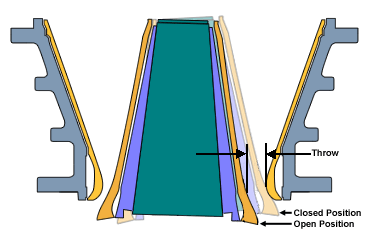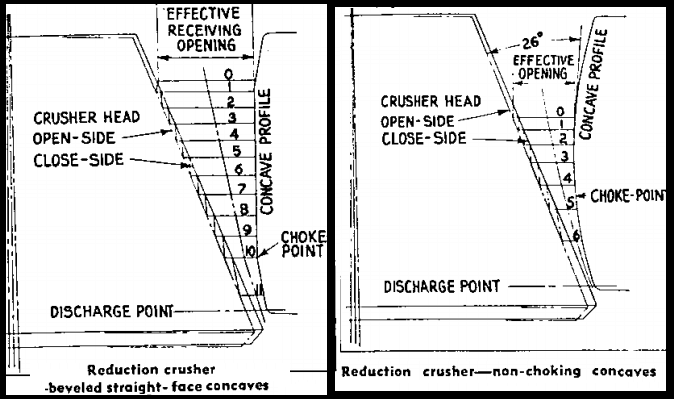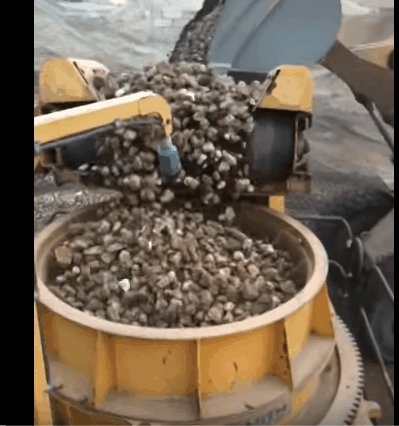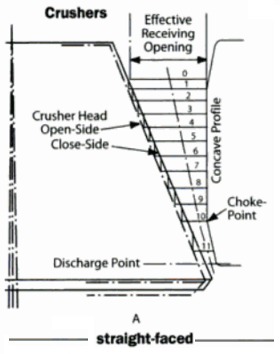Crusher Close Side Settings

The actual minimum safe closed side setting of a crusher will vary somewhat, for any given crushing machine, depending upon the character of the material, the amount of fines in the feed, and whether the crusher is being operated under choke-feed or regulated feed conditions. It is possible, when all conditions are favourable, to operate gyratory crushers, […]
Crusher Performance Factors

It is entirely possible for a crusher to choke at some other point in the crushing chamber than the theoretical choke-point. When the setting of a fine-reduction crusher is too close for its eccentric throw and for the general proportions of its crushing chamber, there is a tendency toward building up a choke in the […]
Crusher Reduction Ratio

I have mentioned the fact that, as the % of voids in the crushing chamber decreases, the production of fines by attrition increases. This is like saying that, as the Crusher Reduction Ratio in any given crusher is increased, the % of fines in the product will increase, even though the discharge setting remains unchanged. Both of these statements […]
How to Prevent Crusher Choking

We all understand how choke feeding a crusher makes for good operation and product size but operators need to also know How to Prevent and avoid that same Crusher from Choking. It is apparent that although the distance between successive horizontal planes increases gradually as these planes move downward (due to increased throw of the […]
High-Speed Gyratory Crushing –> Fine Cone Crushers

I covered briefly the development of various types of reduction crushers of the gyratory family. Below you see a gyratory reduction crusher, which introduced the cylindrical top shell, flared head, and reversible concaves. Even with the older style of straight concaves, with which this machine was originally fitted, it represented a distinct step forward in […]
Effect of Feed on Crusher Performance

If the ore feed to any gyratory or jaw crusher consisted entirely of large cubes or spheres of a size that would just barely enter the crushing chamber, the crusher could not be expected to produce anything like its normal rated capacity because the upper part of the crusher could not shatter the large pieces […]
Jaw Crusher Liner Plate Design & Profile Shapes

Straight Jaw Plates: A shows a diagram of a standard type of Blake crusher with regular or straight jaw plates. This type of plate has been the standard from the time of its inception, emulating, in this respect, the straight concaves in the gyratory machine. And it will be noted that the theoretical action in this straight-plate […]
Gyratory Crusher Concaves

Concaves on the right illustrate the cross section of a typical gyratory crusher, while the left illustrates the same crushing chamber, except that, in place of the straight-face concave, the non-choking type has been substituted. For the sake of direct comparison we have shown the same discharge setting in both diagrams, although a closer setting would be permissible […]
Crusher Concave Profiles

When used for primary or coarse secondary crushing service, the type of crusher described is usually fitted with the style of concave shown on the upper left. These are known as “standard” or straight-face concaves, which have been the standard type of liner ever since the gyratory crusher came into popular use. The distinguishing features of […]
High Capacity Crusher

When the non-choking feature was being applied to existing crushers of the gyratory type, it was found that in several crushing machines, the attendant reduction in receiving opening could be partially offset by sloping the straight portion of the concaves at a wider angle than that for which the top shell was originally designed, because […]
